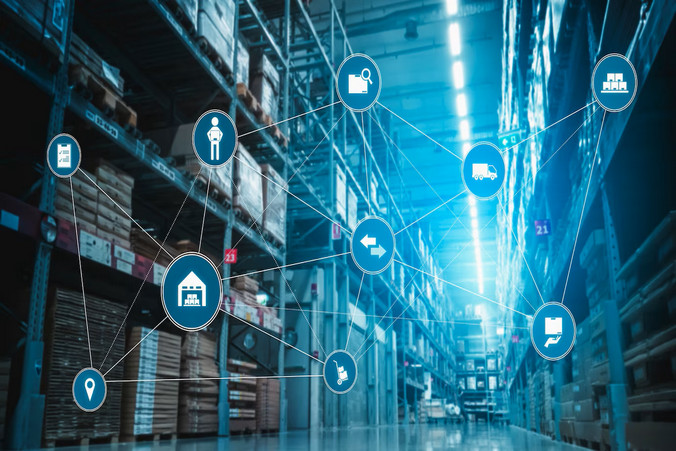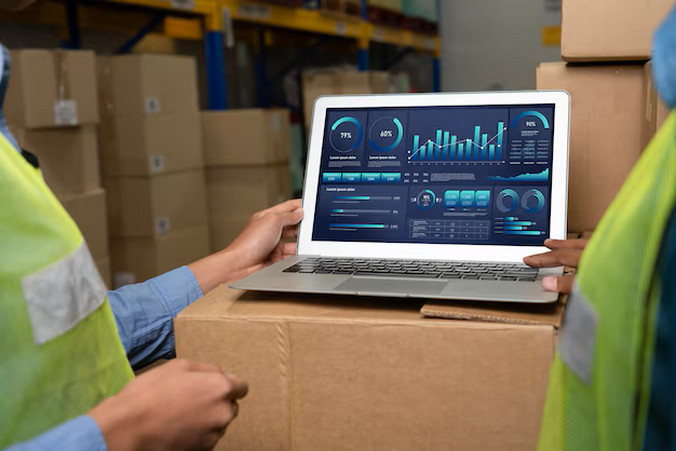In the world of logistics, efficiency and control are crucial to maintaining a smooth operation.…

Reduce supply chain disruptions with technological strategies
Reading Time: 8 minutes
Supply chain disruptions are among the most critical challenges facing global companies today. Whether caused by external factors (such as natural disasters) or internal errors, these disruptions can halt key operations, result in financial losses, and deteriorate customer experience.
According to a study by McKinsey, companies can lose up to 45% of one year’s EBITDA (earnings before interest, taxes, depreciation, and amortization) over a decade due to severe supply chain disruptions.
In this context, technology stands out as a strategic ally. Adopting technological solutions enables companies to anticipate risks, respond more agilely, and strengthen operational resilience.
In today’s article, we explore the most common causes of disruptions and present effective strategies—such as management software and intelligent kitting—to reduce their impact.
🚚 What are supply chain disruptions?
Supply chain disruptions are unexpected events that affect the normal flow of goods, materials, or information throughout the logistics process. These disruptions may be short-term or prolonged, and their impact can range from minor delays to a complete shutdown of operations.
They are considered one of the greatest logistical challenges because they directly affect profitability, operational efficiency, and customer satisfaction. Their frequency and intensity have increased in recent years due to factors like globalization, climate change, and growing market complexity.
🚚 Common causes of supply chain disruptions
Supply chain disruptions are not random. They result from multiple factors that can affect the flow of materials, information, and products. Understanding these causes is the first step toward preventing or mitigating them.
🔧 External factors
External causes are beyond a company’s direct control, but can severely impact supply chain performance:
- Natural disasters. Hurricanes, earthquakes, floods, and wildfires can block logistics routes, damage infrastructure, or shut down factories. For example, the 2011 tsunami in Japan disrupted global production of cars and electronics.
- Geopolitical conflicts. Trade tensions, wars, embargoes, or sanctions can limit access to raw materials, increase shipping costs, or force sudden changes in supply routes. A recent example is how conflicts in the Red Sea have impacted global maritime traffic.
- Pandemics. The COVID-19 crisis revealed the fragility of global supply chains. Border closures, labor shortages, and surging demand for certain products collapsed logistics systems worldwide.
🔧 Internal problems
Internal issues arise from within a company or its suppliers and are often due to lack of control, visibility, or modernization:
- Inventory errors. Discrepancies between real and recorded stock can lead to shortages, production delays, or excess obsolete products—often due to manual processes or outdated systems.
- Supplier failures. Interruptions in material delivery (due to bankruptcy, logistics problems, or lack of inputs) can halt production lines, especially in just-in-time systems.
- Lack of digitalization. Without monitoring and automation technologies, it’s difficult to detect risks in time. Supply chains that still rely on spreadsheets or informal communication are more prone to disruptions.
🔧 Demand shifts
Consumer demand is increasingly volatile and hard to predict. Failure to adapt to these changes can negatively affect the entire chain:
- Unexpected variability. Viral promotions, atypical seasonal shifts, or economic crises can spike or crash demand without warning, making planning and sourcing more difficult.
- Forecasting errors. Relying on outdated data or weak prediction models can lead to overproduction or stockouts, reducing the company’s ability to respond to market needs.
🚚 Key strategies to manage supply chain disruptions
In a global and ever-changing landscape, companies can’t entirely avoid disruptions—but they can build greater resilience. The key is to implement strategies that help anticipate, adapt to, and respond quickly to disruptions.
🔧 Implementation of supply chain management software
Using specialized software (such as ERP, WMS, or TMS) transforms how supply chains are monitored and managed. These platforms provide real-time visibility over inventories, orders, routes, and material availability, enabling informed decisions instantly.
Technologies such as artificial intelligence and machine learning support predictive planning, helping to identify risks, detect anomalies, and simulate future scenarios. A major advantage is the ability to set early alerts for potential issues like supplier delays, low inventory, or sudden demand changes—empowering teams to act before problems escalate.
🔧 Smart kitting strategies
Kitting involves bundling individual components into preassembled kits ready for use or assembly. This not only speeds up production and order fulfillment but also improves internal organization and traceability.
Key benefits include:
- Greater efficiency in picking and order preparation.
- Fewer human errors by reducing handling of individual parts.
- Improved inventory control by working with fully traceable units.
Example: In the automotive industry, kitting helps deliver all necessary components for a specific vehicle part, enabling faster and more precise production under time constraints.
🔧 Supplier diversification and nearshoring
Relying on a single, distant supplier for critical materials increases risk. Diversifying suppliers reduces exposure to localized disruptions, such as geopolitical conflict or shortages.
Nearshoring, on the other hand, involves relocating part of production or supply to nearby countries, which offers multiple advantages:
- Reduced transportation time.
- Better control and communication with suppliers.
- Flexibility to adapt to regional demand.
In a global environment where disruptions can spread rapidly, these strategies provide stability and operational control.
🔧 Automation of logistics and warehousing processes
Automating critical tasks in warehouses or distribution centers boosts efficiency and reduces human error. Technologies that support this include:
- Automated transport systems (AGVs, conveyors)
- Collaborative picking robots
- RFID tracking systems
When integrated with software platforms, these technologies produce real-time data for faster, more strategic decisions.
🚚 Technology as a driver of logistics resilience
In an environment where logistics disruptions can arise at any moment and escalate rapidly, technology has become a fundamental pillar for building resilient supply chains. This is not just for responding to a crisis, but for anticipating it, adapting in real time, and maintaining operational continuity with the least possible impact.
The following technological solutions not only improve supply chain efficiency and visibility but also bring intelligence to every link, enabling more agile, informed, and strategic decisions:
🔧 WMS (Warehouse Management System)
These systems control every aspect of warehouse operations, from goods reception to location, picking, packing, and dispatch. WMS optimizes space utilization, improves inventory accuracy, and accelerates order processing—all fundamental elements for keeping operations moving even under high-pressure scenarios.
🔧 TMS (Transportation Management System)
TMS helps plan, execute, and monitor transport routes efficiently to choose the best combination of routes, transport modes, and costs, considering factors such as delivery time, traffic, and load capacity. It also provides real-time visibility into each shipment, facilitating the detection of delays and the implementation of corrective solutions before they affect the final customer.
🔧 IoT (Internet of Things)
Sensors connected via IoT enable monitoring of critical variables such as temperature, humidity, location, and product status throughout their journey. In sensitive sectors like pharmaceuticals or food, this technology ensures compliance with quality standards and helps prevent losses or damage.
🔧 Advanced analytics and artificial intelligence
The massive data collection through logistics systems, combined with advanced analytics and AI tools, allows for:
- Detecting behavioral patterns.
- Identifying bottlenecks.
- Forecasting potential disruptions.
- Simulating future scenarios to make preventive decisions.
Companies adopting this predictive approach have greater response capacity and adaptability to unforeseen events.
🚚 Benefits of a tech-enabled, resilient supply chain
Investing in technology to strengthen the supply chain is not only a strategic decision but an action with measurable short, medium, and long-term benefits. A technological and resilient supply chain does not merely aim to withstand disruptions but to operate more intelligently, profitably, and sustainably at all times.
Here, we explain the most relevant benefits and how these improvements directly impact business results:
🔧 Shorter response times
Thanks to automation, real-time visibility, and predictive analytics, companies can react immediately to changes in demand, supplier delays, or operational incidents, with benefits such as:
- Improved service levels and delivery fulfillment.
- Reduced production downtime.
- Greater agility to adapt to new business opportunities.
Estimated ROI: Companies integrating advanced planning software have reported up to a 35% reduction in delivery times, according to Deloitte data.
🔧 Improved service levels and delivery fulfillment
A digitized supply chain can offer faster responses, precise information on order status, and timely deliveries. This translates into greater customer satisfaction and loyalty, with tangible benefits such as:
- Strengthened market reputation.
- Reduced complaints and returns.
- Competitive advantage over less digitized competitors.
Estimated ROI: A McKinsey study indicates that improving customer experience through a more agile supply chain can increase revenue by 5% to 10% annually.
🔧 Operating Cost Savings
By automating processes, optimizing logistics routes, avoiding inventory surpluses, and reducing human errors, companies achieve a more efficient operation with lower overall expenses, with advantages such as:
- Reduced transportation, storage, and labor costs.
- Decreased losses due to obsolescence or improper inventory handling.
- Better use of working capital.
Estimated ROI: Organizations adopting advanced logistics technologies can reduce their operating costs by 15% to 25%, according to a PwC report.
🔧 Adaptability to Crises and Market Changes
A resilient supply chain not only recovers quickly from a disruption but also learns and adjusts to prevent similar impacts in the future. This adaptability is vital in an increasingly changing environment and has benefits such as:
- Operational continuity even in uncertain contexts.
- Greater ease in scaling operations or reallocating resources.
- Ability to make data-driven decisions, not assumptions.
🚚 Prepare Today for Tomorrow’s Challenges
Supply chain disruptions are inevitable, but companies can prepare and reduce their impact by implementing technological strategies. Tools like management software, intelligent kitting, and automation enable a more agile, secure, and resilient operation.
If you’re looking for solutions to strengthen your supply chain, at AI Río Bravo, we offer cutting-edge logistics, kitting, storage, and management services.
🚚 Learn about our solutions here
At American Industries Río Bravo, we understand that logistical resilience is built not only with technology but also with well-executed operations, reliable infrastructure, and a specialized team that supports your company at every link in the process.
That’s why we offer a set of strategic services that allow you to anticipate, absorb, and overcome disruptions more easily:
⚡ Efficient and Agile Cross-docking
We minimize handling and storage times by transferring goods directly from a Mexican carrier to a U.S. carrier (and vice versa) through specialized cross-docking: a technique that reduces in-transit inventory, prevents bottlenecks, and accelerates final delivery, especially useful in just-in-time or high-volume operations.
🔒 Flexible Storage Solutions
We have secure, monitored, and adaptable spaces for temporary or prolonged storage of goods. Our logistical capacity allows us to efficiently manage inventories, facilitating product availability without compromising space or excessive costs.
📦 Strategic Distribution for Timely Deliveries
We coordinate the delivery of goods to the appropriate carriers at the precise moment, ensuring that each product reaches its destination with the best combination of speed, traceability, and security. Our strategic location in El Paso and Laredo supports binational coverage.
🔧 Intelligent Kitting for Greater Efficiency
We group, organize, and supply related items into customized kits, ready for use or assembly. This improves production flow and reduces errors in order fulfillment, especially in industries such as electronics, automotive, or medical.
🏷️ Custom Labeling and Repackaging
We offer labeling, relabeling, and repackaging services to ensure regulatory compliance, product traceability, and proper identification during transport. These processes are key to avoiding rejections or customs delays.
💻 Software Management and Data Entry
Our team can operate directly with your company’s ERP, ensuring efficient synchronization with your internal processes. This technological integration reduces human errors and facilitates decision-making with up-to-date information.
🌎 Mexico-United States Customs Agency
We offer expert advice on regulatory compliance and customs procedures on both sides of the border. Our team is trained to keep your operation aligned with the latest regulations, avoiding penalties, delays, and unexpected costs.
Contact us for more information. Learn how American Industries can help you optimize your operations.
❓ Frequently Asked Questions about Supply Chain Disruptions
🏭 Which industries are most affected by supply chain disruptions?
Sectors such as automotive, electronics, pharmaceutical, retail, and manufacturing are highly sensitive to any disruption due to their reliance on components and just-in-time deliveries.
🔮 How can a supply chain disruption be predicted?
With predictive analytics tools, real-time visibility, and historical data-based planning. It’s also key to monitor global news and have contingency plans.
💻 What type of software helps manage these events?
ERP, WMS, TMS systems, and AI-based platforms are fundamental for managing the supply chain in an integrated and proactive way.










